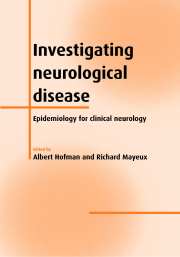Book contents
- Frontmatter
- Contents
- List of contributors
- Preface
- Part I Quantitative methods in clinical neurology
- Part II Neurological diseases
- 10 Cerebrovascular ischemic disease
- 11 Vascular dementia
- 12 Alzheimer's disease
- 13 Parkinson's disease
- 14 Multiple sclerosis
- 15 Myasthenia gravis
- 16 Guillain–Barré syndrome
- 17 Encephalitis and meningitis
- 18 HIV infection
- 19 Prion diseases
- 20 Neoplastic disease
- 21 Cerebral palsy
- 22 Migraine
- Index
13 - Parkinson's disease
from Part II - Neurological diseases
Published online by Cambridge University Press: 29 September 2009
- Frontmatter
- Contents
- List of contributors
- Preface
- Part I Quantitative methods in clinical neurology
- Part II Neurological diseases
- 10 Cerebrovascular ischemic disease
- 11 Vascular dementia
- 12 Alzheimer's disease
- 13 Parkinson's disease
- 14 Multiple sclerosis
- 15 Myasthenia gravis
- 16 Guillain–Barré syndrome
- 17 Encephalitis and meningitis
- 18 HIV infection
- 19 Prion diseases
- 20 Neoplastic disease
- 21 Cerebral palsy
- 22 Migraine
- Index
Summary
Parkinson's disease (PD) is one of the most frequent progressive neurodegenerative diseases in the elderly. In spite of extensive research, the etiology of PD is still unknown. Relatively little epidemiologic research has been conducted on PD. In this chapter, recent developments in epidemiologic research of PD will be reviewed. We will successively discuss risk factors, diagnosis, disease frequency, prognosis, intervention, and implications for clinical practice.
Etiology
Numerous studies on risk factors for PD have been published, but the causes of the dopaminergic cell loss have not been settled yet. Most studies were based on register-based prevalent cases which have some well-known methodologic drawbacks as discussed in Chapter 1. In this section, we will mainly focus either on the few prospective studies in which the exposure was measured before the onset of the disease, or on large cross-sectional studies. Notwithstanding the ample potential for bias in case-control studies based on prevalent cases, we included results from some of the larger case-control studies as well. The results from these studies should however be interpreted with caution. The associations between most putative determinants and PD still have to be confirmed in cohort studies, ideally in a community-based setting.
Age
Age is the most important risk factor for PD. Under the age of 45 years PD is very uncommon. Reported age-specific prevalence and incidence figures varied widely, which might be due to differences in case-finding procedures, diagnostic criteria, and response rates across studies. Case-finding methods that are based on existing medical records will miss patients who did not seek medical attention for their parkinsonism and will tend to underestimate prevalence and incidence.
Keywords
- Type
- Chapter
- Information
- Investigating Neurological DiseaseEpidemiology for Clinical Neurology, pp. 174 - 195Publisher: Cambridge University PressPrint publication year: 2001
- 2
- Cited by

